 Are you leveraging the power of social media on your site?
Are you leveraging the power of social media on your site?
Together, social media channels and your website should work seamlessly to promote your online brand.
However, if you're like most businesses, you're probably missing out on potential interactions, impressions and ultimately sales.
In this article, I'll dive into a quick how-to guide to ensure your business website and social media platforms are working together to maximize your online exposure.
I've included examples from small- to medium-sized businesses that specialize in a whole host of fields to illustrate that you don't have to be one of the big players to take advantage of these simple tips.
#1: Include Visible Social Media Buttons
This seems like a no-brainer, but double-check. Best practices suggest that social media buttons be displayed on the top, bottom or along the side of your home page. Links or buttons that remain in your navigation as the user moves from page to page are optimal.
To ensure that users don't exit your web page altogether, you may want to create the buttons or links so that they open your social media pages in new windows.
Also, do not feel obligated to link out to all social media channels you've created or dabbled in. If you're fonder of Twitter and have completely abandoned your Facebook page, there's no reason to link to any outlet that is not being actively managed. In fact, linking out to inactive channels can ultimately cause more harm than good.
There are several ways in which to display your buttons or links and none of them are wrong. In this case, it is more of a design preference focused on how the user will be interacting with the site.
Below are some examples of ways in which websites have successfully displayed their social media outlet(s).

This eCommerce site specializing in alternatives to dog and horse supplements only links out to Facebook and chooses to do so in a big and bold manner.

This farm credit services business subtly displays their social media buttons at the bottom of their page.
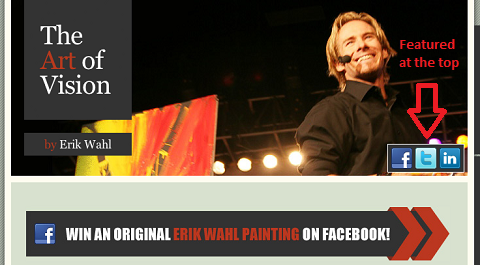
This artist decides to feature his along the top.
#2: Integrate Social Where it Makes Sense
If you use social media to keep your customers or clients apprised of your recent happenings and are actively managing your outlets on a daily or bi-weekly basis, it might be wise to showcase your Twitter feed or Facebook posts directly on your website.
Get World-Class Marketing Training — All Year Long!
Are you facing doubt, uncertainty, or overwhelm? The Social Media Marketing Society can help.
Each month, you’ll receive training from trusted marketing experts, covering everything from AI to organic social marketing. When you join, you’ll also get immediate access to:
- A library of 100+ marketing trainings
- A community of like-minded marketers
- Monthly online community meetups
- Relevant news and trends updates
Linking out or displaying inactive social media channels will only cripple your online efforts. If you choose to go this route, it is important that you maintain your presence.
Below are two examples of how vastly different businesses (a web design firm and an online gift card site) have integrated their social media feeds into their websites.

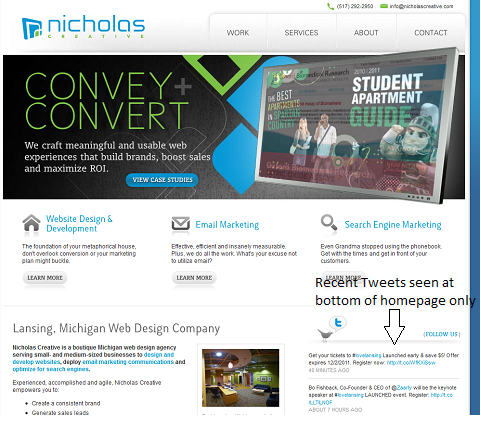
These businesses vary significantly in what they do and the way they make use of social media, but both have found a logical method of incorporating social media into their sites.
#3: Include Up-to-Date Buttons
Social media changes fast—dare we say in real time? So if you added your buttons a year ago, they are probably palling around with the dinosaurs. Facebook fans morphed into Likes, group pages died, +1 is spanking new and LinkedIn improved significantly. Do research to find the most current social media terminology so you don't get caught mumbling about “The Facebook” and “The Twitter.”

In order to maintain credibility within this ever-changing realm, it is important to stay with the times. However, staying up to date with your terminology does not mean that you need to jump on every platform that springs up. It is important to be tactful with your social media choices and do your research before blindly forging into unknown territory.
#4: Include Share Buttons
If you sell a product or run a full-fledged eCommerce site and you haven't added share buttons to your product pages, you are missing out on a whole host of potential social impressions.
Share buttons should enable website-goers to seamlessly share or recommend a product.

Discover Proven Marketing Strategies and Tips
Want to go even deeper with your marketing? Check out the Social Media Marketing Podcast! Publishing weekly since 2012, the Social Media Marketing Podcast helps you navigate the constantly changing marketing jungle, with expert interviews from marketing pros.
But don’t let the name fool you. This show is about a lot more than just social media marketing. With over 600 episodes and millions of downloads each year, this show has been a trusted source for marketers for well over a decade.
If you find yourself hard up for a broad solution for this, check out AddThis or ShareThis. Both provide efficient and easy-to-use solutions for social media sharing across eCommerce sites with the added benefit of analytics to see how the content is getting shared.
As illustrated below, these buttons are easy to see.

Similar to eCommerce sites, if you have resources, articles, a blog or other valuable content on your site, you should attempt to make it as simple as possible for readers to share it with others. Social media share buttons should be displayed somewhere easy to see. Nicholas Creative does a decent job with this, as seen on their blog below.
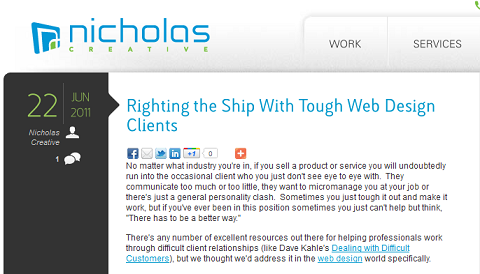
#5: Use Analytics
Pay attention to the way in which individuals are using your social media buttons by tapping into Google Analytics. How many people are actually clicking on your outbound social media links?
An easy way to explore this is by setting up Event Tracking in Google Analytics. If you're unfamiliar with Event Tracking, Google provides a step-by-step guide on how to incorporate the correct codes into your site.

If you find that few individuals explore your social media outlets once landing on your page, perhaps your social media buttons aren't in a convenient location. It's always best to have actual numbers to back up your choices.
#6: Pay Attention to Terms and Conditions
This goes hand in hand with staying up to date and knowledgeable, but I continue to see major brands using social media in ways that violate platforms' terms and conditions.
You cannot use Google+ for contest entries, a personal Facebook page shouldn't be used to operate a brand and there are certain rules to adhere to when running a promotion on Facebook.
The way you use social media reflects on your website, as well as your brand as a whole. If you've accidentally violated some terms and conditions in the past, delete those pages and do not link out to them even in the interim.
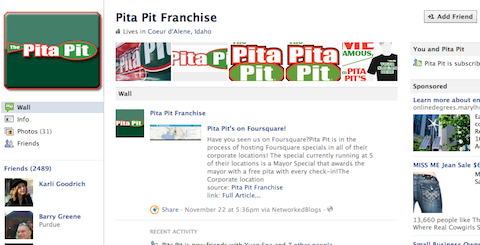
#7: Don't Over-Do It
You want to make sure that compelling information is easily shareable, but littering social media share buttons all over your webpage isn't the way to go. Before adding share buttons to a page, ask yourself, “Is there information here that people would find worth sharing?”
If you find yourself on your “About Us” page and don't see any added value to website-goers being able to share your administrative assistant's contact information, then forgoing buttons in this instance is totally acceptable.
#8: Stay Knowledgeable
Don't get it twisted. With the changing social media landscape and array of rollouts these days, it is easy to confuse social media features. Keep in mind:
- You won't be directing individuals to your Facebook page by installing a Facebook “Like” button on a specific website page. Instead, you are allowing individuals to “Like”/share the information, content or product that is found on that specific website page. There is no correlation between Liking a specific website page and directing users to “Like” your branded Facebook page.
- Similarly, directing individuals to your Google+ brand page is different than adding a +1 button to a page. At this time, there is no correlation between the two.
As illustrated below on this pool supplies website, social media pages and social media share buttons can be found on the same page. Verbs such as “Tweet” and “Share” often help distinguish between share buttons and social media pages.

#9: Use Social Media Insights Alongside Google Analytics
Many types of software allow you to see your social media insights alongside your web analytics in order to pick up on trends and to better understand the successes or failures of campaigns.
SproutSocial allows users to compare web analytics and social media reporting information from specific timeframes side by side. Being able to see the way in which your social media and website analytics relate proves useful in establishing goals, measuring successes and identifying areas in which you can improve.
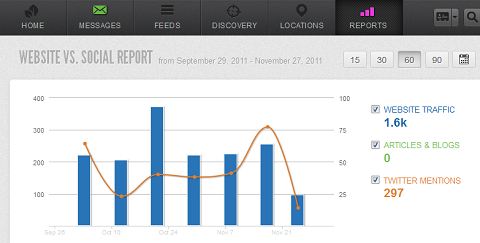
There you have it—a quick-and-dirty guide on immediate steps you can take to make your social media and business website play nice.
Do you have any tips or things to avoid at all costs? Leave your questions and comments in the box below.
Attention Agency Owners, Brand Marketers, and Consultants

Introducing the Marketing Agency Show–our newest podcast designed to explore the struggles of agency marketers.
Join show host and agency owner, Brooke Sellas, as she interviews agency marketers and digs deep into their biggest challenges. Explore topics like navigating rough economic times, leveraging AI, service diversification, client acquisition, and much more.
Just pull up your favorite podcast app, search for Marketing Agency Show and start listening. Or click the button below for more information.

